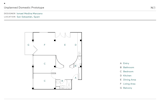Before & After: In Spain, a Compact 1960s Apartment Gets a Quirky, Experimental Retrofit
When it comes to home design, Spanish designer Ismael Medina Manzano thinks we need to shake things up. "We live in a time when society is changing a lot, and there is no single family type or domestic space," says Manzano, who divides his time between New York City and Madrid, where he carries out built projects while pursuing a PhD in advanced architectural projects. "I’m always wondering, can we conceptualize the domestic space as something less fixed and more flexible?"
Manzano brought this open-ended approach to the renovation of a compact apartment in San Sebastián, Spain, owned by friends of a friend. "This apartment has been in the family for a while, but it didn’t meet our needs," says the homeowner. "It was dark and very compartmentalized." Manzano’s task was to bring his research to life, and he sought to transform the apartment into a place that could accommodate many different family members and a range of activities.
Before: Entrance
Located in a 1960s building, the apartment was typical of housing built in northern Spain during that period and it had a standardized, compartmentalized layout. While at the time, many designers thought that closed rooms and rigid floor plans would make domestic life more efficient, the apartment wasn’t working for the owners. "We wanted it to accommodate family members in wheelchairs, kids, or friends who might want to visit," says the homeowner. "The main goal was to create a space for sharing."
After: Entrance
A key intervention in the space was the addition of a curved wall just off the entrance. "We like doing curved things that are not sharply defined," says the designer. "You get more transition and amplification of space." Framing the doorway in locally sourced sandstone highlights regional building materials and traditions in a new way.
"They wanted something more open and lighter," explains Manzano. "Something functional, but at the same time experimental in terms of aesthetics." Adding a curved wall just off the entrance helped open up the space and encourage more flexible use of the common areas. Manzano used local sandstone cut by a stonemason to frame the doorway, and clad the wall in a shiny green ceramic tile which was also locally sourced. "The tile is reflective, and because this wall is one of the darkest in the apartment, we wanted to gather more light with the materiality," says Manzano.
Before: Living Room and Kitchen
Previously, three bedrooms occupied the perimeter of the apartment, and they got the most natural light. Manzano decided to open up one of the bedrooms to create a larger, brighter living area.
After: Living Room
Throughout, Manzano used primary colors like red and blue, and the complementary colors of red and green to connect the apartment with its context. "We wanted to pull the green inside the space, but it’s also sort of a political connection to the green-and-red flag of the region," explains Manzano.
After: Kitchen
The open kitchen/dining/living room is a flexible space that can be transformed for many different uses. An island on wheels can be raised and lowered to function as a dining table, a plant stand, or a work table for different projects. "The mirrored kitchen is incredible," says the homeowner. "We don’t cook daily, so we like that it’s compact and integrates seamlessly with the living room without taking up much space or overshadowing other elements."
Before: Bedrooms
So far, the homeowners have enjoyed the new light-filled space. "When we first walked in after the renovation, two things struck us: the sense of spaciousness, and the light coming in from all directions," says the homeowner. "This was unimaginable before."
After: Bedrooms
With reflective surfaces, moveable furniture, and playful colors throughout, the space invites a multiplicity of uses and avoids a fixed identity. "It’s a space that can be used for anything," says Manzano. "It’s something that gives you energy, because you are able to do so many things."
After: Bathroom
Manzano also took care to ensure that the space was designed for accessibility, as one of the family members uses a wheelchair. "For the bathroom, typically the door would open to the interior, which doesn't provide enough space to move inside with a wheelchair," explains the designer. "So we recommended for the door to open outwards. We also made the bathroom very blue, so it became part of the other colorful things happening in the space."
All told, the homeowners find the new apartment gives them more opportunities to connect with one another, and with the buzz of the city outside. "Usually, we start the day by opening the window and letting in the morning breeze. With coffee in hand, we move between the living room and the terrace. We usually keep the window open all day," says the homeowner. "We love feeling connected to the outside and experiencing the changing light and weather. Every corner of the apartment invites us to enjoy it differently."
More Before & After stories:
In Madrid, a Family of Architects Turn a "Cave" Into a Light-Filled Apartment
In Porto, a Tiny Home Emerges From Ruins
Project Credits:
Designer: Ismael Medina Manzano / @medinamanz_
Builder: Urdaintzi Construccciones
Stone Supplier: La Espiga
Collaborators: Pablo Vives, Sofía Larumbe
Photography: Hiperfocal / @hiperfocal_
Published
Last Updated
Get the Renovations Newsletter
From warehouse conversions to rehabbed midcentury gems, to expert advice and budget breakdowns, the renovation newsletter serves up the inspiration you need to tackle your next project.













